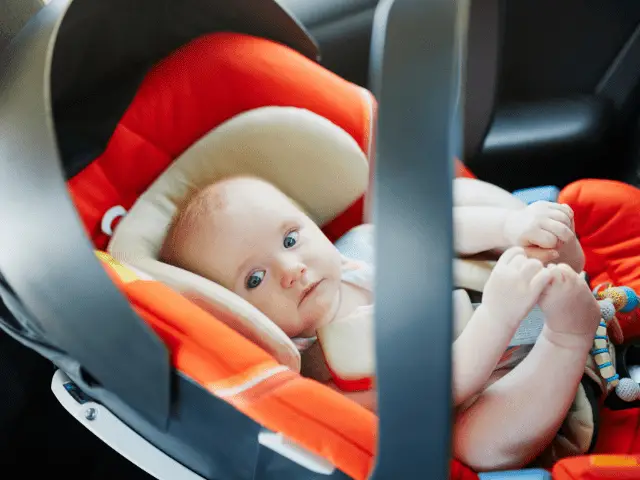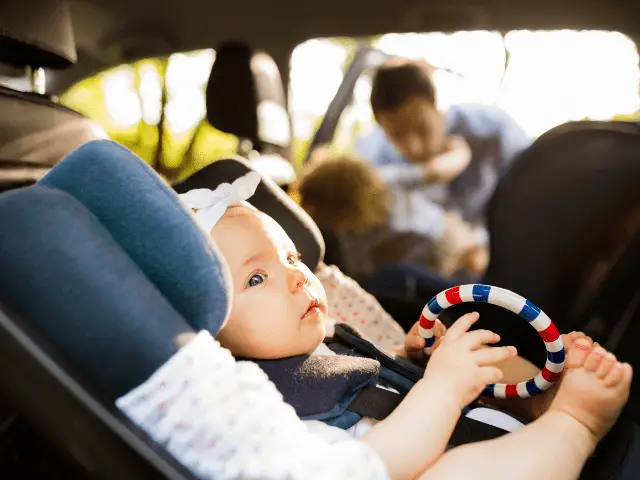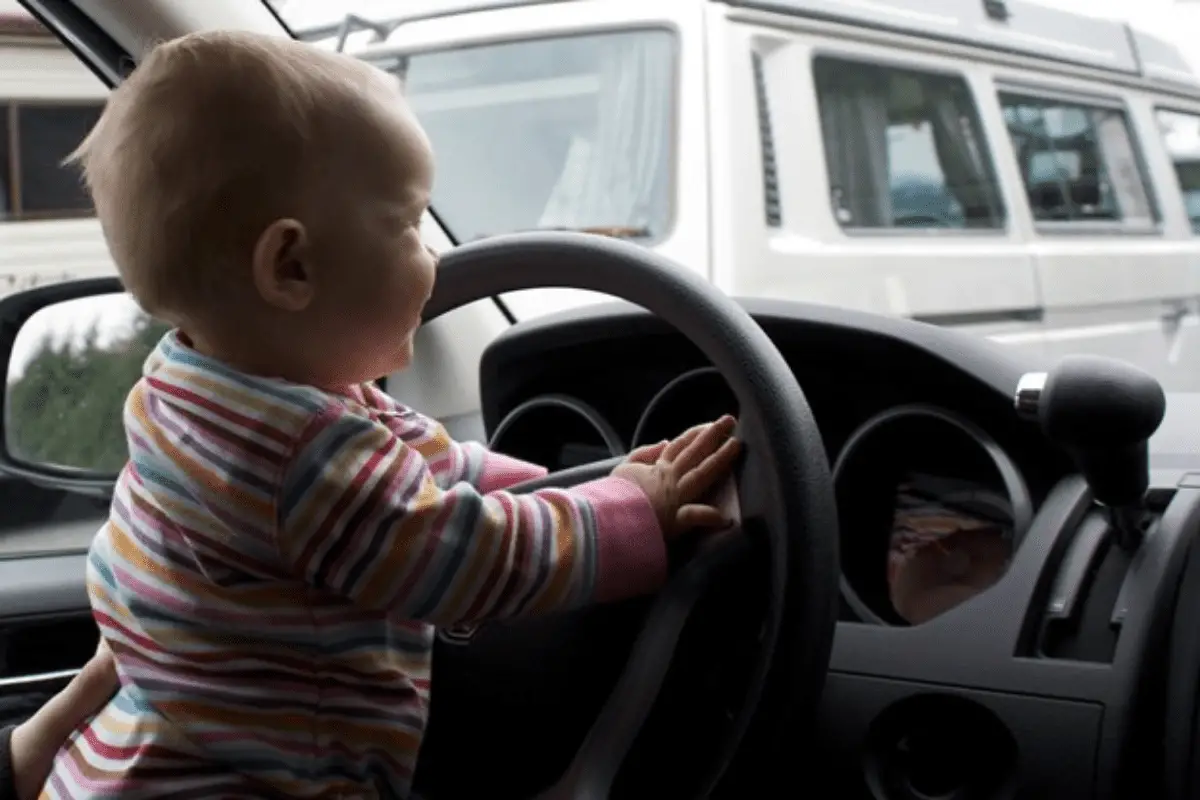Are you planning a cross-country move soon? We can find the logistics of it all daunting. Now add a baby into the mix. Those daunting logistics just became downright impossible. So, how do you survive that cross-country trek with your precious little one?
In 2017, I was just like you. My husband and I were moving cross country from the Panhandle of Florida to our new house in Upstate New York. The trip was over 1300 miles. At the time of the move, our oldest daughter was 9 weeks old and exclusively breastfeeding. We also had to transport all our belongings and our pets.
If my daughter had been a little older, I would have flown her home to my parents and drove our pets home without her, but she was so little and I was a new mom and not ready to part with her even for a day.
So, my husband drove our belongings home in a moving truck and I drove cross country in my car with our pets and the baby.
Overall, it was a strenuous journey. I stopped every two hours to ensure the baby had plenty of time outside of the car seat and I could feed her. I timed dog leash time with every other stop.
We made it to our halfway stop after 12 hours at 8 PM, where we both crashed. We continued the same pattern the rest of the way home on day two.
Finally, I made my best time when she was sleeping and thankfully infants that age sleep a lot.
The advice for how to survive your move across the country when transporting a baby change with his age. Younger babies sleep more, but need significant time outside of their car seats. Older babies will need some distractions and frequent breaks to expel energy.
Below, I will list the biggest pieces of advice for each age group. Most of the advice will be centered around driving for your move based on my own experience and not around other means of transportation.
Take a deep breath and let’s get started.
Table of Contents
Make Your Cross Country Plan
The best way to a successful cross-country move with a baby is to nail the preparation process – planning, planning, planning. Go through the entire process, make a to do list and plan out your baby’s schedule.
You will want to bring ample supplies so that you’re prepared for anything (well, almost anything). Here’s a quick checklist of moving supplies to have readily available in the car.
- Diapers
- Wipes
- Changes of Clothes (for you and them!)
- Cleaning Supplies (for spills and accidents)
- Toys (Favorite stuffed animal for example)
Surviving a Cross Country Move with a Baby (Under 6 Months)

Most babies under 6 months sleep more often than older babies and need less distraction. A car seat mirror is an absolute must if you are making the journey alone. It will not only give you a sight line to your baby but also give you peace of mind during the long naps.
However, babies in this age group feed frequently.
Sleeping
The easiest time to drive your baby is while he is sleeping in the car. It will be the easiest traveling for both of you.
Thankfully, babies under 6 months take at least 3 naps a day. If they are under 3 months, they nap on demand. A smooth car ride is probably the best sleeping aid for a little one.
You will need to be warned, though, that at the end of your long journey, your baby will probably be up for a long period and find it hard to sleep that night. They just spent a long day in the car sleeping.
Activity
While a baby this age sleeps more, he will still need plenty of time to wiggle around and maybe get in some tummy time! Breaks are an absolute must for both you and your baby.
It is recommended for a baby to only be a car seat for 2 hours a day. The semi-upright position that babies sit in a car seat puts too much pressure on their spine and causes strain on their lungs.
There are situations where this just isn’t possible like moving cross country, but you still need to take breaks at least every 2 hours for 30 minutes.
Make sure you do some baby yoga with your bundle of joy. Stretch him, so his back muscles relax and let him really stretch his legs.
Additionally, your little one does not know that you’re moving cross country and some cuddles are very necessary.
If your baby is old enough for sensory toys, pack some. You can attach them to the car seat where the baby can interact with them, but where they are no means a choking or smothering hazard.
Despite what many think, babies get bored, and some sensory toys may ease the drive for them.
Feeding
Dependent on your method of feeding, your plan will vary.
If you are formula feeding, you will need to plan how much you need to bring and enough bottles to survive the number of feedings you will have on the trip. You may clean the bottles along the way, but that sounds like a headache.
You are not supposed to give a baby a bottle in a car seat. We have all done it, but it is not advisable.
Considering you should take driving breaks anyway, it would be best to take the baby out of the car seat for feeding and stretching during a pit stop.
If your baby is breastfed, you will just need to pack your typical nursing items or expressed milk. Most milk coolers can last 12 hours to keep the milk cold.
Finally, if your baby has made it to solid foods, you can pack what they are eating and you can schedule his meals just as you always do.
Surviving a Cross Country Move with a Baby (6 Months and Older)

Traveling with an older infant may be more challenging than a newborn baby or even a younger infant. Babies of this age demand more stimulation and significantly more physical activity. You know what your baby likes best and know what toys and stimulants work best.
For my girls, we listened to nursery songs on repeat. A car mirror will still be your best friend so you can see your baby.
Sleeping
Older babies do not nap as often as younger babies.
By 6 months, my girls were only taking two naps a day, though they were quite long. At this stage, it may be better to drive at night while your little one sleeps. It would certainly make the drive easier if you can do that kind of driving.
If you choose the daytime drive, the car will still lull your baby to sleep. However, just like with a younger baby, they will be wide awake and may struggle to sleep that night.
Activity
Older babies are always on the move. They may find significant time in their car seat incredibly confining. Activity time is mandatory.
Plan breaks for your little one to crawl or run around. This will take extra planning because you will want to find a place that is safe to stop and safe for your baby to play.
As long as the weather is on your side, state parks will give your little one some grass to roll in or a playground to try.
This break will refresh for you, too.
You will face a lower risk of suffocation from toys at this age. You can attach toys to his car seat so that your baby has some sensory stimulations along the drive.
My children all love music and were soothed by it. A phone with hands free connected to your car or a CD of baby songs will be a lifesaver.
Feeding
Babies in this age bracket are usually based on a combination of milk and solid foods. As shown above, if you are formula feeding, you will need to plan how much you need to bring and enough bottles to survive the number of feedings you will have on the trip.
If your baby is breastfed, you will just need to pack your typical nursing items or expressed milk. Finally, pack all the snacks and solid foods that your baby eats in his day.
If you have a standard menu, stick to it. Your baby will adjust to the move better if as little as possible changes. You can even feed your baby what you eat at your meals. Solids feedings add even more supplies to your already packed car.
However, it is just the challenge of the day. You will want to pack plates, bowls, forks and spoons.
Last Notes for Our Tiniest Travelers
It may be best to choose air travel for your little one because it will make the journey shorter.
Also, you will have all your time to focus on your baby and ensure his needs are met.
However, there are many instances where this is not possible, or you simply cannot part with him, your family situation, the cost of moving, or just your own mental well-being may not sustain air travel with a baby.
That is okay!
The general sleepiness of infants will make the drive easier. You will want to plan many breaks for both you and your baby. I would advise to have two adults in the car if possible. It doesn’t hurt to check with family members to see if anyone is willing to help.
Planning your trip, your stops, and all your supplies is vital to this move being successful. When you reach your destination, you will look back on the journey with a sense of pride for the success. It’s definitely an experience you’ll never forget.
Have a toddler making the move with you too? We have more specific info for moving with your toddler that I recommend checking out!

